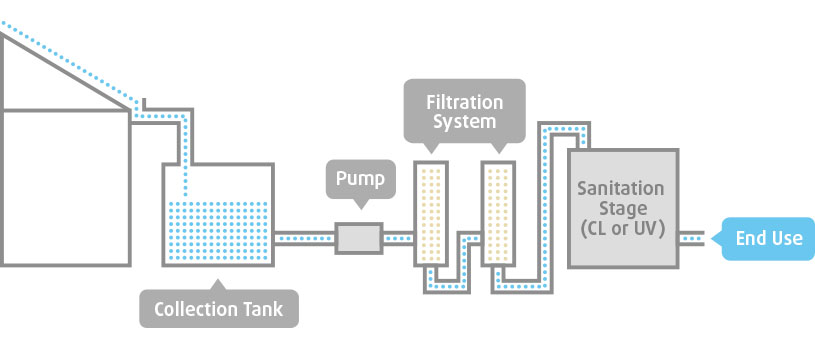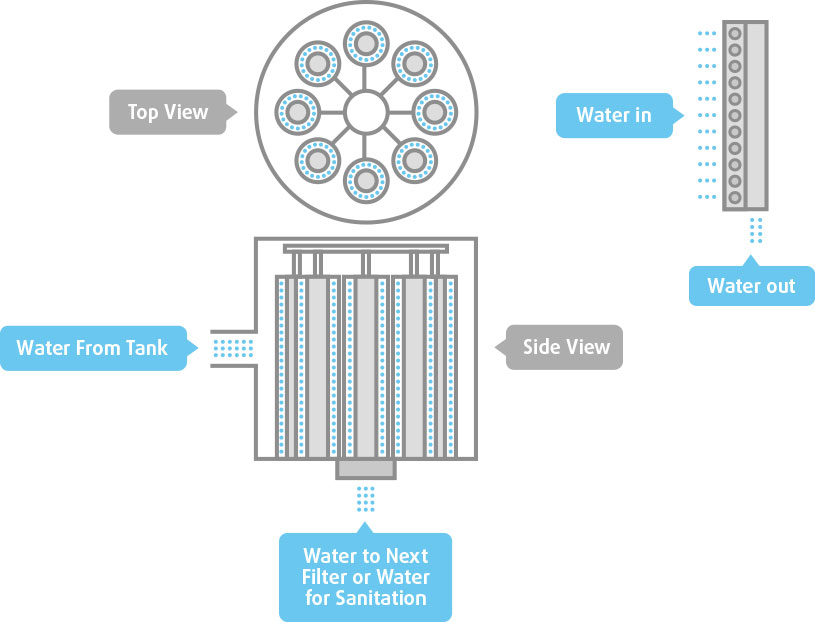Summary of the rainwater harvesting and treatment process
Rainwater harvesting is the process of collecting rainwater for commercial use. Before rainwater is used in a commercial environment, it must undergo several steps of rainwater treatment including sterilisation and filtration.
Cleanawater is an industry leader in rainwater harvesting. To learn more about how your business can benefit from this eco-friendly solution, read on. Get in touch with our expert team for more information.
Rainwater harvesting and collection
The first stage in this process, before treatment can begin, is the harvesting and collection of rainwater. There are many ways to collect rainwater, from dedicated dams to roof runoff gutter systems connected to water tanks. Preliminary stages of water treatment can be introduced at this point, with filters in place to prevent leaves and debris from being collected along with the water.
Sanitation options for rainwater treatment
Two primary sanitisation options are available for rainwater treatment:
- Chlorine Treatment. This is an excellent solution when large amounts of water will be stored for later use and in general industrial applications.
- Ultraviolet Light Treatment. This treatment is commonly used when smaller amounts of stored water are required for a shorter time period and is a great alternative for industrial applications sensitive to corrosion from chlorine exposure.
Businesses located in regions that experience sporadic to heavy rainfall can significantly reduce their water expenses by implementing a rainwater harvesting system. Rainwater treatment and sterilisation are both necessary for making rainwater compliant with regulations and safe to use for your business.
Although rainwater appears to be clean to the naked eye, it is not safe to use until treated as it poses a risk to staff exposed to it. This pathogen-rich rainwater can cause sickness or infections if it comes into contact with open wounds or ingested.

Cleanawater supplies packaged, low maintenance rainwater harvesting solutions to suit all inground and above ground rainwater harvesting applications.
Reduce your business's water bills with a rainwater harvesting system from Cleanawater.
Rainwater harvesting is a great opportunity for businesses who want to reduce operating costs.
Business Applications and Solutions
Example 1: Aluminium Parts Wash Down
A business located in a tropical, heavy rainfall region wants to install a rainwater harvesting system to reduce their water expenses. Collected rainwater will be used immediately after treatment to wash down parts, some of which are made of uncoated aluminium.
Solution
A rainwater harvesting system that uses UV light sterilisation is recommended. The end application of washing down uncoated aluminium means that chlorine poses a corrosion risk, even at low dosing levels.
Example 2: Car Wash
A car wash in Queensland wishes to take advantage of their tropical climate and will use captured rainwater to wash cars.
Rainwater is to be stored and used in the months following rain events. Systems automatically switch between harvested water for car washing and mains water depending on tank storage levels.
Solution
A rainwater harvesting system that uses chlorine for rainwater sanitation is recommended. As the treated water is not used immediately, a UV light approach is not suitable and storage tanks may harbour bacteria when stagnant.
Chlorine present in the water is not an issue given the intended application. The business can safely store rainwater for an extended period of time. This solution an excellent alternative or addition to a water recycling system, which eliminates reliance on mains water.
Treatment Process
Rainwater may contain pollution, animal excrement and other particles which are harmful to humans, plants and animals. Therefore collected rainwater needs to be treated before it is safe to use for business.
There are two primary steps to rainwater treatment: filtration and sterilisation using chlorine or UV light.
Filtration
 The first step of rainwater treatment involves removing sediment and small particles.
The first step of rainwater treatment involves removing sediment and small particles.
Rainwater harvested from roofs travels down a pipe into a storage tank or pit. Dense sediment will settle at the bottom of the tank. A float switch triggers the operation of the system to commence pumping or a pressure drop inline indicates the need to treat and transfer water instantaneously.
Filtration consists of removing 1-5 micron solids via a cartridge, screen or sand filter prior to sanitisation. Filters also have the option to be self cleaning.

Chlorine Sterilisation
Adding chlorine to water is a simple and effective way to sterilise filtered rainwater.
The Victorian Government Department of Human Services recommends the following chlorine dosage and concentration:
- The initial dosage to be a minimum of 5 milligrams of chlorine per litre of rainwater to be treated.
- A concentration of 0.5 milligrams of chlorine for every 1 litre of rainwater must be maintained, 30 minutes after the initial dose.
Therefore for a 50L tank of rainwater, a total of 250mg of chlorine is needed for sterilisation. Then 30 minutes after the initial dose, the concentration must be maintained at 25mg of chlorine per litre.
Advantages of Chlorine Sterilisation
- Chlorine treatment is an ideal solution for rainwater that needs to be stored for future use.
- Rainwater is compliant with the treatment regulations at all times, as a sampling pump will automatically regulate the appropriate chlorine concentration.

Ultraviolet Sterilisation
Ultraviolet light is an alternative method of sterilisation. It works by disrupting and damaging pathogens’ cells.
UV light sterilisation requires rainwater to be virtually free of any large sediment. If the rainwater has not been filtered, 'shadowing' can occur, whereby sediment blocks the UV light rays, reducing the effectiveness of sterilisation.
Advantages of UV Sterilisation
- Ultraviolet lights bulbs have a lifespan of 12 months to 2 years.
- UV units can handle large flow rates.
- UV light treated water can be used immediately after it finishes treatment.
- Rainwater treated with UV is less of a corrosion risk to exposed metal.

Conclusion
Rainwater harvesting is an excellent opportunity for businesses aiming to reduce operating costs.
It is often unknown that collected rainwater isn’t immediately safe to use until correct rainwater treatment has been carried out. A Cleanawater Rainwater Harvesting system will help you both capture and treat rainwater for your business.
Cleanawater's packaged range of Rainwater Harvesting systems are cost effective, portable and ideally suited for your harvesting application.
Ready to discuss how your business can save water through rainwater harvesting? Get in touch with the expert team at Cleanawater today.
Must Read
What to Expect During a Modular Wash Bay Installation
CleanaWater, we make the process of installing a modular wash bay on your site as smooth and straightforward as possible. ...
Read moreThe CleanaWater Team Driving Water Treatment and Sustainability
CleanaWater is powered by a dedicated team of professionals who bring expertise and passion to every project. ...
Read more